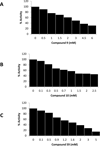Discovery of a new class of inhibitors for the protein arginine deiminase type 4 (PAD4) by structure-based virtual screening
- PMID: 23282142
- PMCID: PMC3521205
- DOI: 10.1186/1471-2105-13-S17-S4
Discovery of a new class of inhibitors for the protein arginine deiminase type 4 (PAD4) by structure-based virtual screening
Abstract
Background: Rheumatoid arthritis (RA) is an autoimmune disease with unknown etiology. Anticitrullinated protein autoantibody has been documented as a highly specific autoantibody associated with RA. Protein arginine deiminase type 4 (PAD4) is the enzyme responsible for catalyzing the conversion of peptidylarginine into peptidylcitrulline. PAD4 is a new therapeutic target for RA treatment. In order to search for inhibitors of PAD4, structure-based virtual screening was performed using LIDAEUS (Ligand discovery at Edinburgh university). Potential inhibitors were screened experimentally by inhibition assays.
Results: Twenty two of the top-ranked water-soluble compounds were selected for inhibitory screening against PAD4. Three compounds showed significant inhibition of PAD4 and their IC50 values were investigated. The structures of the three compounds show no resemblance with previously discovered PAD4 inhibitors, nor with existing drugs for RA treatment.
Conclusion: Three compounds were discovered as potential inhibitors of PAD4 by virtual screening. The compounds are commercially available and can be used as scaffolds to design more potent inhibitors against PAD4.
Figures









Similar articles
-
Protein arginine deiminase 4 (PAD4): Current understanding and future therapeutic potential.Curr Opin Drug Discov Devel. 2009 Sep;12(5):616-27. Curr Opin Drug Discov Devel. 2009. PMID: 19736621 Free PMC article. Review.
-
Revamped role for approved drug: integrative computational and biophysical analysis of saquinavir's peptidyl arginine deiminase 4 inhibition for rheumatoid arthritis.Biochem J. 2024 Oct 16;481(20):1379-1393. doi: 10.1042/BCJ20240366. Biochem J. 2024. PMID: 39312210
-
Profiling Protein Arginine Deiminase 4 (PAD4): a novel screen to identify PAD4 inhibitors.Bioorg Med Chem. 2008 Jan 15;16(2):739-45. doi: 10.1016/j.bmc.2007.10.021. Epub 2007 Oct 13. Bioorg Med Chem. 2008. PMID: 17964793 Free PMC article.
-
Discovery of new inhibitor for the protein arginine deiminase type 4 (PAD4) by rational design of α-enolase-derived peptides.Comput Biol Chem. 2021 Jun;92:107487. doi: 10.1016/j.compbiolchem.2021.107487. Epub 2021 Apr 23. Comput Biol Chem. 2021. PMID: 33957477
-
Peptidylarginine deiminases 4 as a promising target in drug discovery.Eur J Med Chem. 2021 Dec 15;226:113840. doi: 10.1016/j.ejmech.2021.113840. Epub 2021 Sep 9. Eur J Med Chem. 2021. PMID: 34520958 Review.
Cited by
-
PAD4 takes charge during neutrophil activation: Impact of PAD4 mediated NET formation on immune-mediated disease.J Thromb Haemost. 2021 Jul;19(7):1607-1617. doi: 10.1111/jth.15313. Epub 2021 May 12. J Thromb Haemost. 2021. PMID: 33773016 Free PMC article. Review.
-
InCoB2012 Conference: from biological data to knowledge to technological breakthroughs.BMC Bioinformatics. 2012;13 Suppl 17(Suppl 17):S1. doi: 10.1186/1471-2105-13-S17-S1. Epub 2012 Dec 13. BMC Bioinformatics. 2012. PMID: 23281929 Free PMC article.
-
PAD4 and Its Inhibitors in Cancer Progression and Prognosis.Pharmaceutics. 2022 Nov 8;14(11):2414. doi: 10.3390/pharmaceutics14112414. Pharmaceutics. 2022. PMID: 36365233 Free PMC article. Review.
-
Advances in translational bioinformatics and population genomics in the Asia-Pacific.BMC Genomics. 2012;13 Suppl 7(Suppl 7):S1. doi: 10.1186/1471-2164-13-S7-S1. Epub 2012 Dec 13. BMC Genomics. 2012. PMID: 23282089 Free PMC article.
-
Inhibition of NETosis for treatment purposes: friend or foe?Mol Cell Biochem. 2022 Mar;477(3):673-688. doi: 10.1007/s11010-021-04315-x. Epub 2022 Jan 7. Mol Cell Biochem. 2022. PMID: 34993747 Free PMC article. Review.
References
-
- Finesilver AG. Newer approaches to the treatment of rheumatoid arthritis. WMJ. 2003;102(7):34–37. - PubMed
-
- Aceves-Avila FJ, Medina F, Fraga A. The antiquity of rheumatoid arthritis: a reappraisal. J Rheumatol. 2001;28(4):751–757. - PubMed
-
- Rothschild BM, Coppa A, Petrone PP. "Like a virgin": absence of rheumatoid arthritis and treponematosis, good sanitation and only rare gout in Italy prior to the 15th century. Reumatismo. 2004;56(1):61–66. - PubMed
Publication types
MeSH terms
Substances
Grants and funding
LinkOut - more resources
Full Text Sources
Other Literature Sources
Medical

